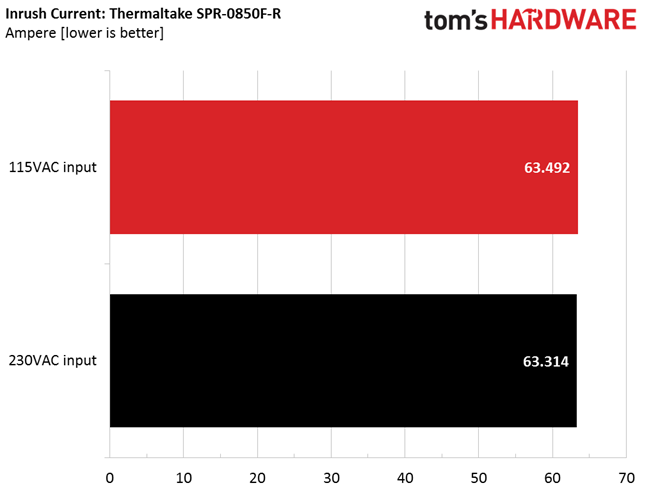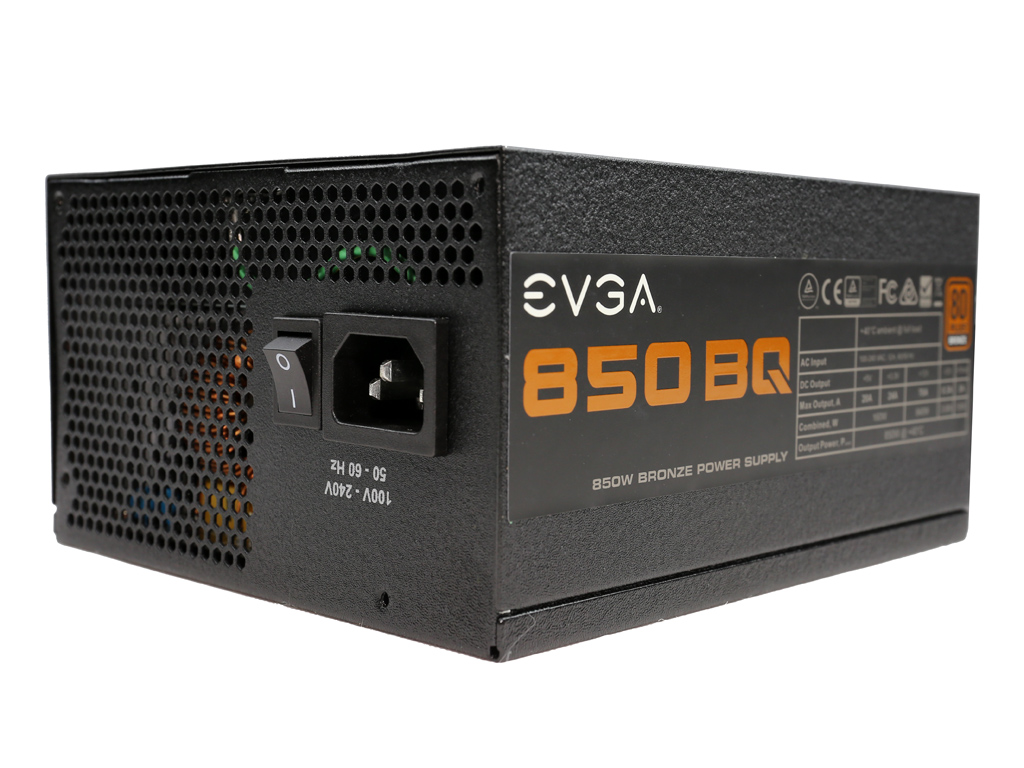Thermaltake Smart Pro RGB 850W PSU Review
Why you can trust Tom's Hardware
Load Regulation, Hold-Up Time & Inrush Current
To learn more about our PSU tests and methodology, please check out How We Test Power Supply Units.
Primary Rails And 5VSB Load Regulation
Load Regulation testing is detailed here.








Hold-Up Time
Our hold-up time tests are described in detail here.







The hold-up time we observed is higher than 17ms. However, the power-good signal doesn't exceed 16ms. At least it's accurate.
Inrush Current
For details on our inrush current testing, please click here.


We measured almost the same inrush current with both 230V and 115V input. Readings above 60A are quite high; we'd like to see inrush currents lower than 50A.
Load Regulation And Efficiency Measurements
The first set of tests reveals the stability of the voltage rails and the SPR-0850F-R's efficiency. The applied load equals (approximately) 10 to 110 percent of the PSU's maximum load in increments of 10 percentage points.
Get Tom's Hardware's best news and in-depth reviews, straight to your inbox.
We conducted two additional tests. During the first, we stressed the two minor rails (5V and 3.3V) with a high load, while the load at +12V was only 0.1A. This test reveals whether a PSU supports Intel's C6/C7 power states or not. In the second test, we determined the maximum load the +12V rail could handle with minimal load on the minor rails.
| Test # | 12V | 5V | 3.3V | 5VSB | DC/AC (Watts) | Efficiency | Fan Speed | Fan Noise | Temps (In/Out) | PF/AC Volts |
|---|---|---|---|---|---|---|---|---|---|---|
| 1 | 5.158A | 1.975A | 1.978A | 0.981A | 84.802 | 81.804% | 1420 RPM | 36.0 dB(A) | 38.56°C | 0.960 |
| 12.256V | 5.070V | 3.329V | 5.085V | 103.665 | 42.45°C | 115.11V | ||||
| 2 | 11.351A | 2.959A | 2.985A | 1.184A | 169.658 | 86.219% | 1475 RPM | 37.5 dB(A) | 39.03°C | 0.983 |
| 12.228V | 5.060V | 3.314V | 5.062V | 196.776 | 45.08°C | 115.10V | ||||
| 3 | 17.928A | 3.467A | 3.514A | 1.385A | 254.888 | 87.372% | 1600 RPM | 38.7 dB(A) | 39.81°C | 0.983 |
| 12.205V | 5.049V | 3.299V | 5.039V | 291.727 | 44.98°C | 115.09V | ||||
| 4 | 24.505A | 3.972A | 4.014A | 1.593A | 339.776 | 87.476% | 1660 RPM | 40.3 dB(A) | 40.69°C | 0.986 |
| 12.185V | 5.037V | 3.285V | 5.015V | 388.420 | 47.14°C | 115.09V | ||||
| 5 | 30.775A | 4.973A | 5.045A | 1.801A | 424.671 | 87.124% | 1680 RPM | 40.9 dB(A) | 41.18°C | 0.988 |
| 12.159V | 5.026V | 3.270V | 4.990V | 487.433 | 48.87°C | 115.08V | ||||
| 6 | 37.075A | 5.983A | 6.085A | 2.011A | 509.653 | 86.493% | 1760 RPM | 42.8 dB(A) | 42.08°C | 0.989 |
| 12.134V | 5.015V | 3.253V | 4.965V | 589.240 | 51.30°C | 115.08V | ||||
| 7 | 43.390A | 7.001A | 7.138A | 2.225A | 594.616 | 85.639% | 1795 RPM | 43.6 dB(A) | 42.89°C | 0.990 |
| 12.111V | 5.004V | 3.236V | 4.938V | 694.327 | 53.91°C | 115.07V | ||||
| 8 | 49.746A | 8.018A | 8.201A | 2.441A | 679.518 | 84.639% | 1815 RPM | 43.7 dB(A) | 43.67°C | 0.991 |
| 12.084V | 4.990V | 3.218V | 4.910V | 802.840 | 48.06°C | 115.07V | ||||
| 9 | 56.554A | 8.539A | 8.767A | 2.446A | 764.573 | 83.728% | 1825 RPM | 43.8 dB(A) | 44.63°C | 0.992 |
| 12.059V | 4.978V | 3.205V | 4.899V | 913.167 | 57.46°C | 115.07V | ||||
| 10 | 63.129A | 9.067A | 9.313A | 3.093A | 849.331 | 82.421% | 1825 RPM | 43.8 dB(A) | 45.08°C | 0.992 |
| 12.033V | 4.965V | 3.189V | 4.844V | 1030.480 | 56.38°C | 115.06V | ||||
| 11 | 70.325A | 9.088A | 9.355A | 3.103A | 934.359 | 81.131% | 1825 RPM | 43.8 dB(A) | 46.45°C | 0.992 |
| 12.011V | 4.951V | 3.175V | 4.830V | 1151.665 | 55.29°C | 115.05V | ||||
| CL1 | 0.100A | 17.022A | 17.003A | 0.005A | 143.268 | 79.120% | 1740 RPM | 42.0 dB(A) | 44.76°C | 0.986 |
| 12.204V | 5.087V | 3.260V | 5.106V | 181.077 | 44.96°C | 115.11V | ||||
| CL2 | 70.793A | 1.003A | 1.003A | 1.002A | 865.765 | 82.652% | 1825 RPM | 43.8 dB(A) | 46.28°C | 0.993 |
| 12.043V | 4.954V | 3.224V | 4.993V | 1047.486 | 51.08°C | 115.06V |
Load regulation on the +12V and 5V rails is within 3%. It's quite loose at 3.3V, though. Moreover, during tests #10 and #11, this rail drops its voltage below 3.2V. While the 3.3V rail is only lightly used, it still needs to stay as close as possible to the nominal voltage. Load regulation at 5VSB is quite bad, landing to close to 6%.
The SPR-0850F-R operates trouble-free under very high ambient temperatures. However, during the full-load and overload tests, its efficiency takes a huge hit. What's more, the fan profile is too aggressive under increased operating temperatures, so don't expect this PSU to be quiet once you stress it. Given the low efficiency rating, we completely understand why Thermaltake preferred an aggressive fan profile. The long warranty also plays a role, since this PSU has to last at least seven years. That won't be easy if it's subjected to high loads most of the time.
MORE: Best Power Supplies
MORE: How We Test Power Supplies
MORE: All Power Supply Content
Current page: Load Regulation, Hold-Up Time & Inrush Current
Prev Page Teardown, Component Analysis & Bonus Safety Video Next Page Efficiency, Temperature & Noise
Aris Mpitziopoulos is a contributing editor at Tom's Hardware, covering PSUs.


